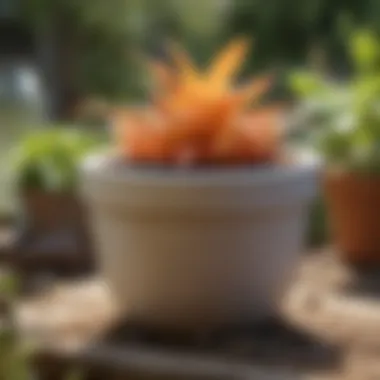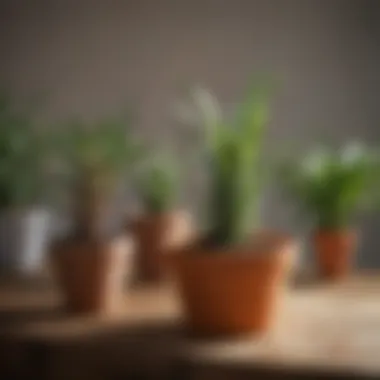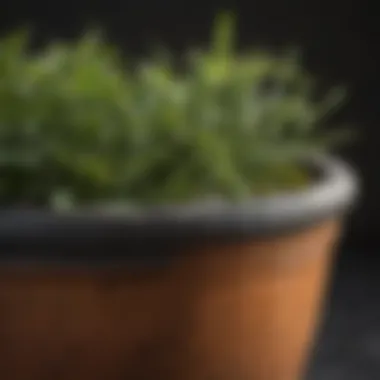Eco-Friendly Pots: Sustainable Choices for Gardeners


Intro
In recent years, the urgency of sustainable practices has been echoed throughout various industries, and gardening is no exception. As those with a love for plants look to embrace eco-friendly options, a significant trend has emerged in the gardening community: eco-friendly pots. These pots are not just trendy accessories; they represent a deeper connection to the environment. By choosing these pots, gardeners not only nurture their plants but also make a conscious effort to minimize their ecological footprint.
This exploration into eco-friendly pots will uncover the various materials used in their production, the benefits they offer, and the innovative designs that enhance their appeal. By understanding these pots, gardeners can align their green thumbs with environmental conservation goals. Whether you’re new to gardening or looking to revamp your collection, the choice of pot can significantly impact the overall gardening experience.
Why Eco-Friendly Pots Matter
Choosing the right pot goes beyond aesthetics; it can significantly influence the health of plants as well as our planet. Using eco-friendly pots:
- Promotes Sustainability: Many eco-friendly pots are made from renewable materials. This reduces reliance on plastics which harm our ecosystems.
- Enhances Plant Health: Certain materials, like biodegradable options, allow for better drainage and aeration, promoting healthier root systems.
- Composts Easily: Some kinds can break down naturally over time, minimizing waste in landfills.
"Opting for eco-friendly pots enhances not just the garden, but also the Earth."
As we unravel the world of eco-friendly pots, we'll dive into their various types, applications in gardening, and how they contribute to enduring sustainability practices.
Preface to Eco-Friendly Pots
The rise of environmental consciousness in recent years has sparked a significant transformation in many areas, including gardening. Eco-friendly pots represent a marriage of aesthetics and sustainability. As gardening enthusiasts become increasingly aware of their environmental footprint, the choice of potting solutions has transcended mere functionality. This section delves into the significance of eco-friendly pots, emphasizing their dual role in promoting healthy gardening practices and sustaining the planet.
Definition of Eco-Friendly Pots
Eco-friendly pots can be understood as containers crafted from materials that minimize harm to the environment, either through biodegradability or sustainability during their production. Unlike traditional plastic pots, which can persist for hundreds of years in landfills, eco-friendly alternatives are designed to break down naturally over time or utilize recycled materials. Essentially, these pots contribute to a closed-loop system where resources are reused, maintaining the cycle of life within our ecosystems. Moreover, they often encourage responsible disposal, allowing homeowners to engage more fully with recycling and compost practices.
Importance of Sustainability in Gardening Practices
Sustainability in gardening is not just a trend; it is a necessary paradigm shift. Here’s why it matters:
- Reduction of Waste: By incorporating eco-friendly pots into gardening routines, enthusiasts can directly contribute to reducing the sheer volume of waste produced. Traditional options are notorious for their persistence in landfills, while sustainable pots can either compost or recycle, providing a lifeline for our environment.
- Promoting Biodiversity: Sustainable gardening practices often translate to healthier ecosystems. Eco-friendly pots can support diverse flora, as many are designed to improve drainage and enhance plant growth, promoting a more vibrant and varied garden.
- Educating the Next Generation: Focusing on eco-friendliness lays the groundwork for future generations. Children who learn about sustainable gardening may carry these values into adulthood, fostering a culture that prioritizes the planet.
By choosing eco-friendly pots, gardeners not only contribute to personal cultivation efforts but also to larger environmental initiatives. It’s an investment that reaps dividends for nature, the community, and the gardener alike.
Materials Used in Eco-Friendly Pots
When we talk about eco-friendly pots, it's essential not only to focus on their functions in gardening but also on the materials that create them. The material used can significantly determine how sustainable a pot is. This further reflects the broader implications of gardening practices on the environment. As more are becoming conscious of their carbon footprints and striving for greener living, understanding the materials used in eco-friendly pots helps make informed choices that align with those values.
Biodegradable Materials
Biodegradable materials are a key player in the world of sustainable gardening. They break down naturally over time, reducing waste. Common examples include materials such as plant-based polymers and certain types of organic fibers. For instance, pots made from starch-based bioplastics offer excellent alternatives to traditional plastic, which lingers indefinitely in landfills.
The beauty here lies in their functionality: as the pot degrades, it adds nutrients back into the soil, enhancing overall soil health. Users can often plant the entire pot into the ground, making the transition seamless without any need for additional plastic disposal. This trend emphasizes the connectedness of gardening and nature, which resonates well with those wanting a more holistic gardening experience.
Recycled Materials
Recycled materials bring another vital dimension to eco-friendly pots. Reusing materials that have already served a purpose transforms something potentially wasteful into a valuable resource for gardening. For example, pots made from recycled plastic bottles have gained popularity. This not only keeps plastic out of landfills but also provides a unique aesthetic appeal. Sometimes you can spot quirky textures or colors from the original items, giving each pot its character.
Another fantastic resource is reclaimed wood. When used for planters, it offers durability and a rustic charm that brings warmth to any gardening setup. However, it's important to ensure that you've sourced the materials responsibly; untreated wood is usually preferred to avoid leaching chemicals into your plants. By choosing recycled materials, gardeners are not just cultivating their plants, but they are also playing a part in a larger movement towards sustainability and resource efficiency.
Natural Clay and Stone
Natural materials such as clay and stone have been around since the dawn of agriculture, and they offer several benefits. Clay pots, for instance, are known for their breathability. They allow for proper air circulation around the roots, which can be great for many plant species. Additionally, clay tends to regulate moisture well, meaning it can help prevent root rot from overwatering.
Stone pots, while heavier and sometimes more expensive, provide excellent durability. They can withstand extreme weather conditions, making them suitable for outdoor gardens. Moreover, natural stone has a timeless aesthetic that can complement any garden design.
"Choosing pots made from natural materials not only enhances gardening outcomes but also connects us to centuries-old agricultural traditions."
Ultimately, whether it's the freshness of biodegradable options, the ingenuity of recycled materials, or the durability of natural clay and stone, the materials chosen for eco-friendly pots can make a significant difference. This decision reflects and supports sustainable gardening practices, enabling enthusiasts to express their green thumbs in a way that aligns with a more sustainable future.


Benefits of Using Eco-Friendly Pots
Choosing the right pots for your plants goes beyond mere aesthetics. Eco-friendly pots bring a range of benefits that elevate both the gardening experience and the planet’s well-being. As we navigate through the world of gardening, understanding the advantages of these sustainable options is crucial. Here’s a closer look at why eco-friendly pots deserve a spot in every green thumb enthusiast's toolkit.
Promoting Healthy Plant Growth
When thinking about plant health, it’s essential to consider not just the plant itself but also the pot it grows in. Eco-friendly pots often utilize materials that promote proper airflow. This is crucial for root development, allowing plants to absorb oxygen and nutrients more effectively. For example, bamboo pots, with their natural permeability, enable roots to breathe while also preventing water logging, a common issue in conventional plastic pots.
Moreover, many of these pots are designed with organic materials. This means that they can gradually break down as the plant grows, enriching the soil with essential nutrients over time. Hence, investing in eco-friendly pots can lead to a thriving garden that is not only visually appealing but also healthier and more vigorous.
Reducing Environmental Impact
Every time we make a purchase, we cast a vote for the kind of world we want to live in. By opting for eco-friendly pots, gardeners consciously reduce their environmental footprint. Traditional plastic pots can take centuries to decompose and often end up in landfills, contributing to waste and pollution. In contrast, biodegradable pots such as those made from coconut coir or compostable materials break down naturally, returning to the earth as organic matter.
Additionally, using pots crafted from recycled materials, like those originating from post-consumer plastics, helps to cut down on the need for virgin materials. This practice not only conserves resources but also supports a circular economy in which products are reused and repurposed. The act of planting can become a part of a larger narrative towards sustainability and environmental stewardship.
Enhancing Soil Quality
Soil health is at the heart of successful gardening. The material of the pot can significantly affect the soil’s quality. Eco-friendly pots made from part compost or natural fibers often allow nutrients to seep in, enhancing the soil quality. Over time, these pots contribute to a better microbial ecosystem, which is vital for plant survival.
The gradual breakdown of these materials into the soil can also improve its structure. Healthier soil retains moisture more effectively and supports the life of beneficial organisms necessary for robust plant growth. By choosing eco-friendly options, gardeners can ensure that they are not just planting seeds in a pot, but nurturing life from the ground up.
"The choice of pot isn’t just about where you plant; it's about how you cultivate a sustainable future."
Types of Eco-Friendly Pots
When it comes to gardening with a conscience, understanding the** types of eco-friendly pots** is key. These pots not only serve their practical purpose but also align with the principles of sustainability that many modern gardeners embrace. Choosing the right pot is a matter of personal values and environmental awareness. Each pot type has unique properties that cater to various gardening needs—whether you’re looking for durability, biodegradability, or aesthetics. This section walks you through some notable eco-friendly options that can add a green touch to your green thumb endeavors.
Compostable Pots
Compostable pots are designed to break down and enrich the soil once they’ve outlived their usefulness. Made from natural, organic materials, these pots can completely decompose under the right conditions, leaving no trace behind. One of the principal benefits of compostable pots is their zero-waste philosophy. Users can plant them directly into the ground without needing to transplant, reducing the stress on plants that can come from being moved from one container to another.
*Why Choose Compostable Pots?
- Easy Planting: Just place them in the soil, and they’ll decompose naturally.
- Soil Enrichment: As they break down, they add nutrients back into the earth.
- Biodegradable: They leave no plastic residue, which is a bonus in any sustainable gardening plan.
"Using compostable pots contributes to a more circular approach to gardening, where nothing goes to waste and everything nourishes".
Coconut Coir Pots
Coconut coir pots, made from the fibrous husks of coconuts, have gained popularity due to their unique moisture retention properties. They create a breathable habitat for roots and prevent overwatering—ideal for gardeners with a tendency to keep the watering can a little too close.
Coconut Coir Pots Have Some Pretty Impressive Features:
- Sustainable Source: They’re created from a natural byproduct of coconut processing.
- pH Neutral: This keeps soil healthier, avoiding issues that can arise with acidic materials.
- Biodegradable: Similar to compostable pots, they’ll break down naturally in a home compost heap.
Bamboo Pots
Bamboo pots fuse beauty and functionality. These pots are not just aesthetically pleasing; they also boast a sturdy construction. Bamboo is one of the fastest-growing plants, making it a sustainable option for gardeners seeking durability without sacrificing eco-friendliness.
Benefits of Bamboo Pots Include:
- Natural Pest Resistance: Bamboo has properties that can deter pests, which means healthier plants without harmful chemicals.
- Strong and Lightweight: They are easy to move around, making them convenient for mobile gardening setups.
- Stylish Design: Their natural look makes them a great addition to any garden style.
Fabric Pots
Fabric pots take a different approach to gardening, allowing roots to breathe and thrive. These pots are made from permeable materials that let water drain out while keeping the soil intact. This prevents root rot while also promoting healthy root development.
Advantages of Fabric Pots:


- Temperature Regulation: They keep roots cool in the summer and warm in the winter, supporting year-round growth.
- Lightweight: Ideal for urban gardeners with limited space, as they can easily be moved around.
- Reusable: They can be used for several seasons, making them a cost-effective solution in the long run.
Navigating the waters of eco-friendly gardening can be a complex task, but understanding various pot types lays a solid foundation for environmentally conscious choices. Each pot type offers distinct benefits and considerations, allowing gardeners to evaluate what fits their needs best.
Innovative Designs in Eco-Friendly Pots
Innovative designs in eco-friendly pots represent the convergence of sustainability and creativity, pushing the boundaries of traditional gardening. These designs are crucial not only for improving plant health but also for encouraging gardeners to adopt more responsible practices. As we grapple with a changing environment, the appeal of pots that are both practical and environmentally friendly becomes even more relevant. Thus, exploring these innovations allows us to appreciate how functionality can blend seamlessly with eco-consciousness.
Self-Watering Pots
Self-watering pots are a remarkable advancement in sustainable gardening. These pots come equipped with a reservoir that allows plants to absorbed moisture as needed. This innovation solves many worries of plant enthusiasts—especially those who lead busy lives—by simplifying the watering process. The pots help keep consistent soil moisture without the risk of overwatering, thus preventing root rot.
In addition to water conservation, self-watering designs promote healthier root development. The roots can grow stronger, reaching towards the moisture below while also gaining air exposure above. Moreover, these pots can be crafted from recycled or biodegradable materials, enhancing their eco-friendly credentials. Just imagine a gardener effortlessly tending to their plants while reducing both their labor and waste footprint. The evolution of watering techniques has indeed come a long way.
Vertical Gardening Solutions
Vertical gardening solutions embody the essence of innovation, perfect for urban landscapes, where space is at a premium. These designs typically utilize wall-mounted frames, containers, or trellises, allowing gardeners to cultivate herbs or flowers without occupying precious ground area. The vertical approach not only maximizes limited spaces but also adds a unique aesthetic element to any environment.
What makes vertical gardens particularly appealing is their capacity to improve air quality while beautifying surroundings. This setup encourages diverse growth and attracts beneficial insects, resulting in a vibrant ecosystem. Besides, vertical gardens can be designed from sustainable materials, ensuring that they deliver both form and function. In essence, vertical gardening speaks to the heart of eco-friendly urban living.
Modular Pot Systems
Modular pot systems emerge as a clever solution to cater to the diverse needs and styles of gardeners. These systems comprise interlocking or stacking pots, allowing flexibility in arrangement and design. This innovation can cater to various plants, growth stages, or aesthetic preferences with ease. The ability to rearrange or expand as desired offers an enticing sense of control over one's gardening journey.
Moreover, modular systems can integrate features like drainage trays, built-in self-watering mechanisms, or even hydroponic setups. These systems not only support a wide range of plant types but also encourage diverse methodologies of care and maintenance. Modular pot systems make it incredibly easy to swap out plants and redefine space while keeping sustainability in focus.
"Innovative pot designs in gardening signify a commitment not just to aesthetics, but also to the planet and our future."
As we navigate through plant care, the innovative designs discussed align with the principles of sustainability while meeting functional requirements. These pots do not just facilitate growth; they inspire a culture of mindful gardening that can resonate across communities. In summary, these advancements lay a solid foundation for a more sustainable gardening practice, capturing the hearts of green thumbs everywhere.
Challenges with Eco-Friendly Pots
In an era where sustainability takes the center stage, eco-friendly pots resonate with gardeners, bringing with them not just environmental consciousness but also several challenges. Understanding these hurdles—like durability, availability, costs, and thermal properties—is essential for anyone committed to cultivating their green thumb without compromising on their principles or aesthetics.
Durability Concerns
One of the foremost concerns about eco-friendly pots is their durability. Traditional pots boast resilience that can withstand the test of time, often outlasting their plant inhabitants. However, many sustainable options, such as biodegradable materials like peat or even those made from recycled paper, face limitations when it comes to longevity.
When exposed to the elements, these materials can break down more rapidly than one might expect. For instance, a bamboo pot adorned with vibrant foliage might look great at first but could lose its integrity in a matter of weeks during the rainy season. Gardeners venture into these territories, ideally equipped with knowledge on how long each type would last in their specific conditions.
Availability and Cost Issues
The availability and cost of eco-friendly pots can also be a sticking point for many enthusiasts. Unlike conventional planting options, which are readily stocked at most gardening centers, sustainable pots might not be on every shelf. This can lead to frustration when trying to source them locally or even online.
Moreover, this limited availability often translates to higher prices. Think about it: while a plastic pot might set you back just a couple of dollars, a compostable pot could be triple that. For small-scale gardeners or those on a tight budget, this financial barrier can be daunting, causing some to think twice before committing to eco-friendly alternatives. It’s a balancing act—saving the planet while keeping the wallet happy is no easy feat.
Temperature and Moisture Retention
Temperature regulation and moisture retention are key considerations in the world of planting. Eco-friendly pots can struggle to maintain consistent temperatures compared to their non-biodegradable counterparts. Traditional materials are generally more efficient at insulating their contents from fluctuating external temperatures, but that’s not always the case for innovative pots made from organic matter.
Take the example of a cloth fabric pot. While it allows for excellent drainage and aeration, offering plants a comfy home, it may also lead to faster drying out of the soil. This means gardeners need to be vigilant, making more frequent trips to water their plants. In contrast, rigid plastic pots tend to keep moisture for longer, requiring less frequent watering.
Utilizing eco-friendly pots demands an understanding and adjustment in gardening strategies, including how often and when to water your plants. Adjustments are crucial.
"Gardening is often about finding harmony between nature and our own desires. A balance between eco-friendly choices and garden standards is necessary."
In summary, while eco-friendly pots deliver on sustainability, they bring along a set of challenges that every gardener needs to consider. Durability, availability, costs, and thermal properties can greatly influence the gardening experience. Keeping these factors in mind will help enthusiasts make informed decisions, ensuring their gardens flourish alongside their environmental values.


Aesthetic Considerations in Eco-Friendly Pot Design
When discussing eco-friendly pots, one can't help but think about their functionality. However, the importance of aesthetics in eco-friendly pot design deserves equal spotlight. After all, what good is a sustainable product if it doesn't fit well in our outdoor spaces or, heaven forbid, clashes with our personal taste? The aesthetic appeal of pots can influence a gardener's choice and ultimately their gardening experience. These elements not only enhance the visual landscape but also serve as a reflection of the gardener’s style and values.
Visual Appeal
The look of an eco-friendly pot can vary widely based on the materials used and the design choices made. For instance, biodegradable pots can be elegantly crafted to resemble ceramic, adding a sophisticated touch to any garden. They come in various shapes, colors, and textures, appealing to diverse tastes. One recent trend incorporates earthy tones that blend seamlessly with natural surroundings, making them an appealing choice for gardeners who value harmony in their outdoor aesthetic. Moreover, distinctive patterns or subtle engravings can give these pots personality and uniqueness, drawing the attention of visitors.
But let’s not ignore the downsides. While beauty is in the eye of the beholder, the longevity of these designs is sometimes in question. For example, some cheaper biodegradable options may not stand the test of time, often leading buyers to magic wand their pots away in a moment of frustration. Therefore, choosing an aesthetically pleasing pot shouldn't come at the cost of durability.
"Beauty and sustainability can go hand in hand, elevating both the garden and the planet."
Integrating with Outdoor Spaces
The way eco-friendly pots fit into outdoor settings is a key consideration for gardeners. When you're dealing with limited space like in apartments or urban settings, every piece needs to earn its keep. An eco-friendly pot ought to harmonize with the overall gardening theme while also serving practical functions.
Consider vertical gardens, which are increasingly popular in urban environments. They often utilize compact, visually appealing pots that can easily blend into a vertical structure, making the entire setup not only a space saver but also a visual masterpiece. Similarly, pots that mimic natural elements like stone or wood provide a rustic feel, enhancing the organic ambiance of the outdoor area.
Additionally, adding decorative elements such as plant stands or layering pots can create a visual narrative in your garden. These tricks offer an opportunity to integrate pottery designs that are functional and aesthetically pleasing, ensuring that your eco-conscious choices don’t compromise your garden’s appearance. Moreover, similar colors or materials across a broader design palette can create a cohesive look that delights the eye while promoting an eco-friendly ethos.
In summary, the aesthetics of eco-friendly pots play a crucial role in making gardens not just functional green spaces but attractive outdoor treasures. Blending aesthetics with sustainability nurtures a culture of creativity in gardening, where one’s values are reflected through thoughtful design and careful selection.
The Role of Eco-Friendly Pots in Urban Gardening
In a world where concrete jungles are rapidly replacing green spaces, the role of eco-friendly pots in urban gardening becomes ever more crucial. These pots not only contribute to the aesthetic of an urban environment but also serve as a vital tool for sustainability. Embracing eco-friendly pots means supporting a new way of gardening that is attuned to the limitations and opportunities within city settings.
Supporting Small Scale Gardening
Urban areas often present unique challenges when it comes to gardening. Many city dwellers have limited access to backyard space, leading to smaller, more compact gardening projects. Eco-friendly pots are an indispensable component of this small-scale gardening movement. They cater to the needs of urban gardeners by being lightweight and easy to handle.
Using materials such as biodegradable composites or recycled plastics, these pots can support various plant types, from flowers to herbs. Importantly, they provide a low-impact option for residents eager to grow their own food but limited by their surroundings.
With eco-friendly pots, individuals can cultivate small gardens on balconies, rooftops, or windowsills. For example, using fabric pots made from recycled materials allows gardeners to grow plants effectively even in confined spaces. These pots can effectively manage moisture levels and promote healthy growth without relying on synthetic materials, thus minimizing environmental damage.
Moreover, the use of small, eco-friendly pots aligns seamlessly with community gardening initiatives. Neighborhoods can come together, sharing space and knowledge, all while using sustainable materials. These communal efforts generally foster a greater sense of connection among residents and encourage urban biodiversity.
Facilitating Gardening in Limited Spaces
Limited space is a unique hurdle urban gardeners must overcome. Eco-friendly pots offer numerous advantages precisely because they are designed with space constraint in mind. They are available in various sizes, making it feasible to fit multiple pots into a singular area. Additionally, many eco-friendly options can be stacked or hung, thereby enhancing the gardening experience without consuming precious ground space.
Furthermore, using pots made from materials like coconut coir or bamboo can also benefit urban spaces by bolstering their environmental health. These materials may include added nutrients for the soil, which promotes better plant growth and improves local air quality.
Urban gardening made more accessible through eco-friendly pots does more than just beautify a space. It cultivates a deeper relationship with nature, urging city dwellers to act responsibly toward their environment. The focus on sustainable gardening encourages a broader discussion about waste reduction, food scarcity, and local eco-systems.
“Urban gardening using eco-friendly pots allows city dwellers to take an active role in environmental stewardship, transforming the landscape of our cities one plant at a time.”
Final Thoughts on Eco-Friendly Pots
As we wrap up our exploration of eco-friendly pots, it becomes clear that the decisions we make in gardening can resonate far beyond just our backyards. These pots aren't merely containers for plants; they symbolize a shift towards more sustainable practices in our daily lives. The choices we make are underpinned by a desire not just to nurture our gardens but also to protect the environment we cherish.
Evaluating Personal Choices
In choosing eco-friendly pots, one must carefully consider individual needs and lifestyle. Do you have the time and space for compostable pots that can later enrich the soil, or are you leaning more toward durable options made from recycled materials that might endure several seasons? Self-reflection plays a pivotal role here. As a gardener, asking oneself how these choices affect both plants and the planet is essential. The little decisions we make—whether it’s opting for a bamboo pot or a fabric one—add up to significant changes in our environment.
When looking at personal choices, it’s also important to think about the eco-credentials of the products we purchase. This involves researching brands and understanding the materials used. Some pots might advertise themselves as eco-friendly but lack the certifications to back up their claims. Each purchase becomes a chance to support sustainable businesses and foster a community dedicated to protecting our natural surroundings.
"The act of gardening does not solely pertain to nurturing flora; it embodies stewardship of the earth itself."
The Future of Sustainable Gardening
The path forward in sustainable gardening is brimming with promise. Innovations in materials and designs are creating a dynamic landscape for eco-friendly pots. As technology and ecological consciousness intertwine, we see the emergence of pots that boast functionality while maintaining an commitment to sustainability.
New compostable materials are being developed that break down even faster without compromising the plant growth environment, a welcome advancement for gardeners focused on reducing waste. Furthermore, as urban gardening becomes more popular, solutions like vertical gardens equipped with eco-friendly containers will continue to expand gardening’s accessibility, especially in cities where space is a premium.
The future also compels us to think critically about our waste management practices. The move toward a circular economy—where products are reused and recycled rather than disposed of—will drastically influence the gardening industry. In this context, eco-friendly pots may evolve even further, transforming how we approach plant care and fostering a mindset that values sustainability at every level.
Engaging with community gardens or planting small crops on balconies can bolster environmental responsibility and enhance food security. Such initiatives may ignite an environmental awareness that resonates beyond our own gardens, planting seeds of change in local communities.
Ultimately, the journey toward sustainable gardening is an evolving landscape. It challenges us to not only improve our gardening practices but also to rethink our relationship with the planet. Who knows? The eco-friendly pots we choose today may pave the way for a greener tomorrow.







